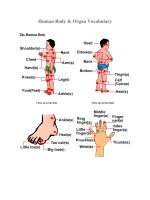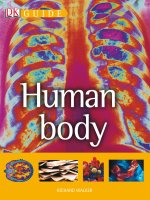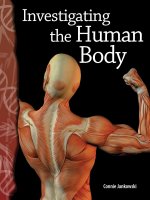eye wonder human body
Bạn đang xem bản rút gọn của tài liệu. Xem và tải ngay bản đầy đủ của tài liệu tại đây (13.87 MB, 48 trang )
Eye Wonder
Open your eyes to a world of discovery
Eye Wonder
Open your eyes to a world of discovery
Eye Wonder
First American Edition, 2003
03 04 05 10 9 8 7 6 5 4 3 2 1
Published in the United States by
DK Publishing, Inc
375 Hudson Street
New York, New York 10014
Copyright © 2003 Dorling Kindersley Limited
All rights reserved under International and Pan-American
Copyright Conventions. No part of this publication may be
reproduced, stored in a retrieval system, or transmitted in any form
or by any means, electronic, mechanical, photocopying, recording,
or otherwise, without the prior written permission of the copyright
owner. Published in Great Britain by Dorling Kindersley Limited.
Library of Congress Cataloguing-in-Publication Data
Bingham, Caroline, 1962-
Body / by Caroline Bingham ; consultant, Daniel Carter.
p. cm. (Eye wonder)
Includes index.
Summary: A brief introduction to the human body, including some
facts about sleep
ISBN 0-7894-9044-7
1. Body, Human Juvenile literature. [1. Body, Human. 2. Sleep.] 1.
Carter, Daniel. II. Title. III. Series.
QM27 .B564 2003
306.4 dc21
2002009547
ISBN 0-7894-9044-7
Color reproduction by Colourscan, Singapore
Printed and bound in Italy by L.E.G.O.
See our product line at
www.dk.com
Written and edited by Caroline Bingham
Designed by Helen Melville
Managing editor Sue Leonard
Managing art editor Cathy Chesson
Category publisher Mary Ling
US editor Christine Heilman
Jacket design Chris Drew
Picture researcher Marie Osborn
Production Shivani Pandey
DTP Designer Almudena Díaz
Consultant Daniel Carter
Thanks to Penny Arlon for editorial assistance
4-5
Everyone looks different
6-7
but we are all alike inside
8-9
Babies and belly buttons
10-11
Life in a bag
12-13
A bag of bones
14-15
Hairy stuff
16-17
Move that body
18-19
Pump that blood!
20-21
A circular tale
22-23
Puff, puff
24-25
Attack of the bugs
26-27
Let’s talk
LONDON, NEW YORK, MUNICH,
MELBOURNE, and DELHI
Contents
28-29
Brainpower
30-31
Touch
32-33
Listen up!
34-35
Eye, eye
36-37
Smelly stuff
38-39
Fun with taste
40-41
Take a bite
42-43
From food to poo
44-45
Sleep tight
46-47
Glossary
48
Index and
acknowledgments
Tall, short, plump, thin, blond, dark Even
though we have two eyes, a nose, two arms,
and so on, we still all look so different that
we can recognize each person we know
without getting anyone confused.
Everyone looks different
H
u
m
a
n
b
e
i
n
g
s
a
r
e
d
i
f
f
e
r
e
n
t
i
n
a
l
l
s
o
r
t
s
o
f
w
a
y
s
.
I
t
i
s
t
h
o
u
g
h
t
4
There are slight differences
between the left- and right-
hand sides of your face.
•
The average human body
contains enough iron to make
a nail 1 in (2.5 cm) long.
•
Brown or black skin has
more of a pigment called
melanin in it than white skin.
•
You inherit certain features
(such as hair color or body
shape) from your parents.
Body facts
t
h
a
t
m
o
r
e
t
h
a
n
6
,
5
0
0
l
a
n
g
u
a
g
e
s
a
r
e
s
p
o
k
e
n
t
h
r
o
u
g
h
o
u
t
t
h
e
w
o
r
l
d
.
What about twins?
Only identical twins
look alike, and that is
because they develop at
the same time, from one
egg that has split into
two. Identical twins are
always the same sex.
5
but
The lungs make
up a part of the
respiratory system.
Building blocks
A number of organs
may make up each body
system. For example,
the stomach, liver,
intestines, gallbladder,
and pancreas make up
your digestive system.
6
Y
o
u
r
b
o
d
y
i
s
a
c
o
l
l
e
c
t
i
o
n
o
f
s
y
s
t
e
m
s
,
e
a
c
h
o
f
w
h
i
c
h
h
a
s
a
j
o
b
t
o
d
o
.
Stomach
Liver
Many of your
organs are packed
neatly into your
torso (the part
without the head
and limbs).
All bodies are made up of organs. Skin is an organ. It is
wrapped around a framework of bones and other organs
such as the heart, the brain, and the lungs.
we are all alike inside
It would take about
200 of your cells to
cover a period.
Cell
Nucleus
A TALL STORY
The tallest man
ever recorded, Robert
Wadlow, grew to 8’11” (272 cm).
He was born in the US in 1918,
and died in 1940. He was known
as the Gentle Giant. He grew so big
because too much growth hormone
was released into his body.
What does an organ do?
Organs work to keep you alive, and each
does a different job. Organs work together
to make up systems, such as the muscular
system and the circulatory system.
Made of tissue
Organs are made up
of tissue, which is made
of groups of similar cells.
These magnified cells
are from the lungs.
Different cells
Cells are different depending
on the organ they are a part
of – skin cells, for example, are
different from bone cells. Most cells
have a nucleus – the control center.
7
Y
o
u
r
b
o
d
y
h
a
s
a
b
o
u
t
5
0
,
0
0
0
b
i
l
l
i
o
n
c
e
l
l
s
.
8
Babies and belly buttons
•
At just eight weeks, the
fetus can be recognized as
human – although it is shorter
than your little finger.
•
Fingernails begin to form
when the fetus is about
ten weeks old.
•
A fetus can get hiccups.
Baby facts
They can hear you!
A baby can hear noises from around its
mother’s tummy – it can hear you talking or
laughing, and it will recognize your voice.
A race to the egg
Millions of sperm swim
toward the mother’s egg to
fertilize it, though only about
one hundred get near it. Just
one sperm fertilizes it.
Legs here, arms there
After the egg has been fertilized,
it begins to divide, becoming a ball of
cells. It is full of instructions for what
the baby will look like.
We all begin life inside our mother as a tiny egg.
This develops after it is joined, or fertilized, by a
sperm from the father. Most babies spend about
40 weeks growing in their mother’s tummy.
How does it breathe?
The fetus cannot eat or
breathe until birth, so it gets
food and oxygen from its mother
through a special cord. At birth
this cord is cut, and shrivels
away to leave the belly button.
The fetus is
protected in
a sac of fluid.
The cord that
attaches a baby to
its mother is called
the umbilical cord.
10
Your skin is a fabulous bag for
your body. It’s stretchy and
waterproof. It helps to control
your body’s temperature, and
it protects you from germs.
Life in a bag
A unique print
Everybody has
a unique set of
fingerprints, but
there are three
main types: arch,
loop, and whorl.
Skin facts
•
About 50,000 tiny flakes
of dead skin drop off your
body every minute!
•
Millions of microscopic
dust mites live in your bed,
gobbling up the skin flakes
that fall off you.
I
n
m
o
s
t
p
l
a
c
e
s
,
y
o
u
r
s
k
i
n
i
s
a
b
o
u
t
1
⁄
1
6
i
n
(
2
m
m
)
t
h
i
c
k
.
11
What’s underneath?
Skin contains sweat glands, hair follicles,
nerve endings, and tiny blood vessels called
capillaries. Underneath, there’s a layer of fat.
My feet are wrinkly!
Spend a long time swimming
and the thicker skin on your
feet and hands will begin to
wrinkle because water has
soaked into it. The extra
water makes it pucker up.
Sweat it off
You sweat to keep
cool – but did
you know that in
a fingernail-sized
patch of skin there
are between 100 and
600 sweat glands?
Skin alert cure that cut!
Cut yourself and a lot of activity
in the surrounding skin causes the
blood to clot. The resulting scab
stops dirt and germs from getting in.
Flakes of dead
skin fall off your
body all the time.
Cells lock together to
provide a waterproof layer.
What’s a bruise?
Bruises are caused by damage
to the tiny blood capillaries
that run just under the skin’s
surface. If broken by a heavy
knock, they bleed into the
surrounding area.
A bag of bones
Bones protect your internal
organs from damage and act
as a frame to hold you up.
They are linked together by
muscles and tendons to make
up your skeleton.
Bony hands
More than a quarter of
your bones are in your
hands. An adult has
27 bones in each hand.
The number of
bones in the
hands makes
them very
flexible.
Extra bones
A baby’s skeleton
is largely cartilage,
the stuff that holds
your nose out and
makes it bendy.
12
•
Compared to a steel bar
of the same weight, a bone is
far stronger.
•
You have the same number
of neck bones as a giraffe.
•
Bones need calcium from
foods like milk and cheese to
make them hard.
Bone facts
Hidden support
If you cut through a femur, or
thigh bone, you’d see that the
inside is a spongy honeycomb.
This makes it strong, but light.
Joints
A joint is the place
where two bones meet.
This is a hip joint,
which is a ball-and-
socket joint. It gives lots
of movement.
It’s broken!
If you break a bone, an X-ray
shows the doctor what is going
on beneath the skin. Bones
are living tissue, and will
usually mend, with rest and
support, in about 6–8 weeks.
The rounded
end of the femur
fits snugly into
the pelvis.
Pelvis
Femur
Y
o
u
r
b
o
n
e
s
a
r
e
f
u
l
l
o
f
b
l
o
o
d
v
e
s
s
e
l
s
,
n
e
r
v
e
s
,
a
n
d
c
e
l
l
s
.
This X-ray shows
two broken legs.
An adult
skeleton
contains
206 bones.
13
14
Hairy stuff
Your hair and nails are made of
the same thing. It’s called keratin,
and most of it is dead. In fact,
your hair and nails are only
alive at the roots. That’s why
it doesn’t hurt to cut your
hair or trim your nails.
A hairy tale
Hair grows over most of
your body. The thickest
is on your head, where you
have between 100,000 and
150,000 hairs!
This close-up of eyelash
hairs shows how they grow
from follicles in the skin.
Each hair is made
of overlapping
plates of keratin.
15
Are you right-handed?
If so, the nails on this hand
will grow faster than those
on the left. This is controlled
by the brain.
Head lice
Head lice love
to cling to hair,
suck our blood,
and lay their
eggs. Get rid
of them with
special shampoo.
Scratchy head?
If your head itches,
you may have head
lice. You can see
their eggs as tiny
white spots in the
hair above your ear.
F
i
n
g
e
r
n
a
i
l
s
g
r
o
w
f
o
u
r
t
i
m
e
s
f
a
s
t
e
r
t
h
a
n
t
o
e
n
a
i
l
s
.
A female head louse
will lay 50–150 eggs.
Like hair, your nails
are made of millions
of overlapping
plates of keratin.
16
Step forward and you’ll use about
200 muscles. You have at least
600 muscles, and they are responsible
for every movement you make, from
jumping to blinking to breathing.
Bend your arm
Try tensing the muscle
in your upper arm, your
biceps. Can you feel
it getting harder?
A closer look
A muscle is made up of bundles
of tiny fibers. Each fiber is
incredibly thin – much
thinner than a hair.
The biceps has
contracted.
The triceps
has relaxed.
MUSCLE MOUSE
The word “muscle” comes
from the ancient Romans,
who thought that muscle
movements under the skin
looked just like a mouse
running around. Their word
for mouse was musculus.
Move that body
17
How do they work?
Muscles can only pull, so they
work in pairs. In your arm, the
biceps pulls by contracting to
bend the arm and the triceps
pulls to straighten it.
Make a face!
Your face is full of muscles.
Incredibly, you use 17 of these
muscles to smile. However, you
use about 40 muscles to frown!
The muscles in
our face allow us
to make about 10,000
different facial expressions!
•
Your muscles make up 40
percent of your body’s weight.
•
Help your muscles grow big and
strong by eating lots of protein.
That means lots of eggs, meat,
cheese, and beans.
•
Muscles can contract to
one-third of their size.
Muscle facts
All joined up
Many muscles are
joined to the ends
of the bones they
control by stringy
cords called tendons.
A
s
a
m
u
s
c
l
e
c
o
n
t
r
a
c
t
s
,
i
t
g
e
t
s
s
h
o
r
t
e
r
a
n
d
h
a
r
d
e
r
.
A
s
a
m
u
s
c
l
e
r
e
l
a
x
e
s
,
i
t
g
e
t
s
l
o
n
g
e
r
a
n
d
s
o
f
t
e
r
.
Clench your fist and
you can see a tendon
working under the
skin of your wrist.
18
Can you feel your heart beat? This amazing
muscle never gets tired, even though it opens
and closes about 100,000 times a day, every
day, throughout your life.
Pump that blood!
Where is it?
Your heart is protected by
your rib cage. It is slightly
to the left of your chest.
A one-way system
Your heart beats to
push blood around your
body. Four valves ensure
that the blood always
goes the same way.
Speed up!
Run and your
heart beats
faster. This
gets more
oxygen to
your muscles.
Held with string
Heart strings are tiny
cords that stop the valves
from turning inside out
when they close.
A
h
e
a
r
t
h
a
s
f
o
u
r
c
h
a
m
b
e
r
s
.
19
What is blood?
Blood is made up
of a watery liquid
called plasma, red
cells, white cells,
and fragments of
cells called platelets.
A tangled web
This is what happens
when your blood
clots because of a
cut. The red cells
are caught in a
mesh of fibers. They
die and stop blood
from flowing out.
Red blood cells
Red blood cells make up
about 44 percent of your
blood. Millions are made
and destroyed every second.
Fighting infection
White blood cells and
platelets make up less
than one percent of
blood. They fight germs.
•
At rest, a child’s heart beats
about 85 times a minute.
•
A drop of blood contains
approximately 250 million red
cells, 275,000 white cells, and
16 million platelets.
•
A blood cell goes around
your body and back through
your heart more than 1,000
times each day.
Heart/blood facts
R
e
d
c
e
l
l
s
a
r
e
d
o
u
g
h
n
u
t
-
s
h
a
p
e
d
.
Plasma makes
up about
55 percent
of your blood.
The mesh forms
very rapidly.
Your heart pumps blood around
your body through arteries and
veins. Arteries carry blood away
from the heart. Veins carry
blood toward the heart.
A change of color
As blood travels through
the lungs, it picks up
oxygen. This makes it
brighter in color. As it
releases oxygen around
the body, it grows darker.
A ONE-WAY SYSTEM
Almost 400 years ago, an English
doctor named William Harvey
discovered that blood circulates one
way around the body, pumped by the
heart. Harvey drew
detailed diagrams
of arteries and
veins to show
what he
meant and
published
his results
in 1628.
A circular tale
Most to the brain
Your brain needs a constant
supply of oxygen-rich blood.
It is so important that it gets
20 percent of your body’s
blood supply.
Smaller and smaller
Arteries and veins become a
branching network of capillaries.
The capillary walls are so thin
that gases, nutrients, and waste
products pass easily through.
A close-up of an artery
This cross-section of an artery is
magnified so much that the red blood
cells can be seen. Arteries usually
have thicker walls than veins.
Feel the beat
You can feel your heart’s beat as it
sends a pulse through the artery in
your wrist. Hold your index finger
against the inside of your wrist.
The regular beat is the surge of
pressure that occurs when the
heart contracts.
Oxygen-rich
blood
Oxygen-
poor blood
Most veins (shown
in blue) carry
blood that contains
carbon dioxide,
a waste gas.
A blood cell travels
around your body in
about 60 seconds.
Y
o
u
r
f
i
n
g
e
r
s
a
n
d
t
o
e
s
a
r
e
t
h
e
c
o
o
l
e
s
t
p
a
r
t
s
o
f
y
o
u
r
b
o
d
y
.
A
n
a
d
u
l
t
’
s
b
l
o
o
d
v
e
s
s
e
l
s
s
t
r
e
t
c
h
9
9
,
4
0
0
m
i
l
e
s
(
1
6
0
,
0
0
0
k
m
)
.
Your brain is
the hottest part
of your body.
Most arteries (shown in
red) carry blood rich with
oxygen and food.
Blood supply to
the brain.
Kidney
Lung
Stomach
Lung
Brain
Liver
Kidney
22
Believe it or not, you take about 23,000 breaths each
day. With every breath, you take in oxygen, which
you need to stay alive, and you breathe out a gas
called carbon dioxide, which your body doesn’t need.
Puff, puff
A wind tunnel
Air travels down your
windpipe, or trachea,
to get to your lungs.
In this photograph,
you can see the rings
of cartilage that hold
the trachea open.
Taking out the oxygen
The air tubes (shown red) get smaller and smaller
until they end in millions of tiny air sacs called
alveoli. Here, oxygen is taken into your blood.
Air passes down
your windpipe,
or trachea, and
into your two lungs.
Air tube
These spaces
are air sacs
called alveoli.
23
Blowing bubbles
We can only store oxygen for a short
time in our lungs. Also, unlike fish,
we have no gills to remove oxygen
from water. So we cannot stay
underwater without an air supply.
W
HY DO I GET HICCUPS
?
Hiccups happen when the muscle that helps
to move air in and out of your lungs, your
diaphragm, jerks uncontrollably. Nobody
really knows why they happen, but there are
lots of suggestions for stopping them.
Try breathing into a paper bag or ask
a friend to scare you or (yummy!)
put sugar under your tongue.
•
Stethoscopes, which doctors
use to check breathing, were
invented in 1816.
•
You breathe faster during
and after exercise to draw
more oxygen into your body.
•
Your left lung is smaller
than your right lung to allow
room for your heart.
Lung facts
There’s water, too
Your breath contains
water. If you breathe
onto a cold surface,
this water condenses
into tiny droplets. That
means it changes from
a vapor into a liquid.
The same thing
happens on a cold day.
24
B
a
c
t
e
r
i
a
c
a
n
d
o
u
b
l
e
t
h
e
i
r
n
u
m
b
e
r
s
i
n
2
0
m
i
n
u
t
e
s
!
Attack of the bugs
Beastly bacteria
Bacteria come in lots of funny
shapes. Some even have tails! If
a cut becomes infected (it will
look red and swollen), that’s
because bacteria have
gotten in.
What are germs?
Germs fall into two
main groups: bacteria
and viruses. Your
body is good at
keeping them out,
but they are clever
at finding ways in.
Vile viruses
Have you had chicken pox?
It’s caused by a virus. So is the
common cold. Viruses are tiny –
far smaller than bacteria.
Everywhere you go, you are surrounded
by nasty germs, and many of them
want to live inside your body.
After all, it makes a comfy home.
The problem is, they can make you ill.









